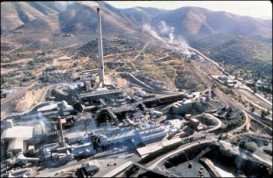Challenges In Indian Country
This section discusses the Challenges facing Tribes on water quality issues found on the Reservations, ceded lands, and Treaty rights. Our first set of challenges posted here have to do with hard rock mining. Please note that the Presentations are listed as is and also including the notes with the presentations. There will be more updates to this portion as time goes on.
The first Challenge is the Coeur d’Alene Tribe and their struggles to protect their precious lake.
The Coeur d’Alene Tribes Fight to Protect Their Precious Lake.
After a century of mining pollution pouring into Coeur d’Alene Lake the Coeur d’Alene Tribe has fought to have the toxic pollution cleaned up by EPA using Super Fund authority. Unfortunately the State of Idaho would not allow this to happen since they felt it would, “stigmatize” the region and result in a decline in “tourist dollars” that flood the region, especially during the summer months. Since no Superfund actions can occur within a State where remedial actions would take place, if the State does not approve the EPA Superfund Record of Decision (ROD), the State of Idaho had great political influence over the cleanup of Lake Coeur d’Alene.
So rather than use their Superfund authority to address this enormous hazardous waste contamination, the current EPA plan is to “defer” a Superfund remedy
for the Lake and instead leave the 75 million tons of contaminated lake bed sediments at the bottom of the Lake and force the State and Tribe to manage the metals
in place via a nutrient management plan (the Lake Management Plan or LMP). This plan was designed to keep metals bound to lake bed sediments by always maintain
oxygen in the water column in theMiningDistrict1 hypo-limnion (the deep, cold, dark portion of the water column).

The way to keep oxygen in the water is to minimize nutrients that pour into the Lake from a myriad of sources (most of which are unregulated non-point sources, such as agricultural runoff, road building, deforestation, etc.). As folks know, nutrients act to “fertilize” the lake which increases primary production of phytoplankton (algae) and therefore, increase the zooplankton (the critters that eat the algae). This make the lake look green in the summer but as fall turns to winter these lifeforms die and fall to the lake bottom. Once on the lake bottom they decompose. Decomposition uses oxygen and can create sags or depletion of oxygen. When there is no oxygen in the water the metals which are normally tightly bound to the bed sediments (under oxygenated conditions) liquefy (under reduced conditions, or oxygen depleted conditions) and enter the water column. That is the science and that is the grave concern the Coeur d’Alene Tribe faces.
The problem we now face is instead of EPA using its Super fund authority; they forced us to develop the LMP which has no authority to regulate or funding to reduce nonpoint source nutrient pollution. When we seek funding through Clean Water Act competitive funding we get denied or receive “crumbs”. Ten years of water quality monitoring is showing clear degradation of the parameters of greatest concern and time is running out before we see serious algal blooms, anoxia, and metals releases. The Tribe is now trying to breakdown the “stove piping” between EPA Region 10s CWA program and the Superfund program to bring both those program leads to the table to require them to do their job, that job is to protect the Tribe and the region from the toxic legacy of unbridled mining pollution.
Please view our presentations listed on our struggle to clean up Lake Coeur d’Alene.
- Comparisons Report Final
- Hardrock Mining Risks To Community Health
- Hidden Dangers Presentation 4-22-13
- Hidden Dangers Presentation 4-22-13 notes

 The way to keep oxygen in the water is to minimize nutrients that pour into the Lake from a myriad of sources (most of which are unregulated non-point sources, such as agricultural runoff, road building, deforestation, etc.). As folks know, nutrients act to “fertilize” the lake which increases primary production of phytoplankton (algae) and therefore, increase the zooplankton (the critters that eat the algae). This make the lake look green in the summer but as fall turns to winter these lifeforms die and fall to the lake bottom. Once on the lake bottom they decompose. Decomposition uses oxygen and can create sags or depletion of oxygen. When there is no oxygen in the water the metals which are normally tightly bound to the bed sediments (under oxygenated conditions) liquefy (under reduced conditions, or oxygen depleted conditions) and enter the water column. That is the science and that is the grave concern the Coeur d’Alene Tribe faces.
The way to keep oxygen in the water is to minimize nutrients that pour into the Lake from a myriad of sources (most of which are unregulated non-point sources, such as agricultural runoff, road building, deforestation, etc.). As folks know, nutrients act to “fertilize” the lake which increases primary production of phytoplankton (algae) and therefore, increase the zooplankton (the critters that eat the algae). This make the lake look green in the summer but as fall turns to winter these lifeforms die and fall to the lake bottom. Once on the lake bottom they decompose. Decomposition uses oxygen and can create sags or depletion of oxygen. When there is no oxygen in the water the metals which are normally tightly bound to the bed sediments (under oxygenated conditions) liquefy (under reduced conditions, or oxygen depleted conditions) and enter the water column. That is the science and that is the grave concern the Coeur d’Alene Tribe faces.